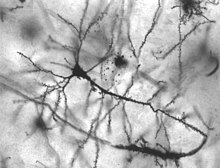
Back اضطراب عصبي Arabic Malaltia neurològica Catalan Enfermedad neurológica Spanish اختلال عصبی Persian Trouble neurologique French הפרעה נוירולוגית HE 신경계 질환 Korean Neurologische aandoening Dutch ਮਾਨਸਿਕ ਵਿਕਾਰ Punjabi Transtorno neurológico Portuguese
| Neurological disorder | |
|---|---|
 | |
| Neurons in person with epilepsy, 40x magnified | |
| Specialty | Neurology |
A neurological disorder is any disorder of the nervous system. Structural, biochemical or electrical abnormalities in the brain, spinal cord or other nerves can result in a range of symptoms. Examples of symptoms include paralysis, muscle weakness, poor coordination, loss of sensation, seizures, confusion, pain, tauopathies, and altered levels of consciousness. There are many recognized neurological disorders, some are relatively common, but many are rare.
Interventions for neurological disorders include preventive measures, lifestyle changes, physiotherapy or other therapy, neurorehabilitation, pain management, medication, operations performed by neurosurgeons or a specific diet.[1][2] The World Health Organization estimated in 2006 that neurological disorders and their sequelae (direct consequences) affect as many as one billion people worldwide, and identified health inequalities and social stigma/discrimination as major factors contributing to the associated disability and their impact.[3]
- ^ KT, Thakur; E, Albanese; P, Giannakopoulos; N, Jette; M, Linde; MJ, Prince; TM, Steiner; T, Dua (14 March 2016). "Neurological Disorders". Mental, Neurological, and Substance Use Disorders: Disease Control Priorities, Third Edition (Volume 4). Chapter 5 Neurological Disorders. Washington (DC): Patel V, Chisholm D, Dua T, et al. pp. 87–107. doi:10.1596/978-1-4648-0426-7_ch5. ISBN 978-1-4648-0426-7. PMID 27227247.
- ^ Cite error: The named reference
ZisHadjivassiliou2019was invoked but never defined (see the help page). - ^ "WHO | Neurological Disorders: Public Health Challenges". March 14, 2007. Archived from the original on 14 March 2007.
© MMXXIII Rich X Search. We shall prevail. All rights reserved. Rich X Search